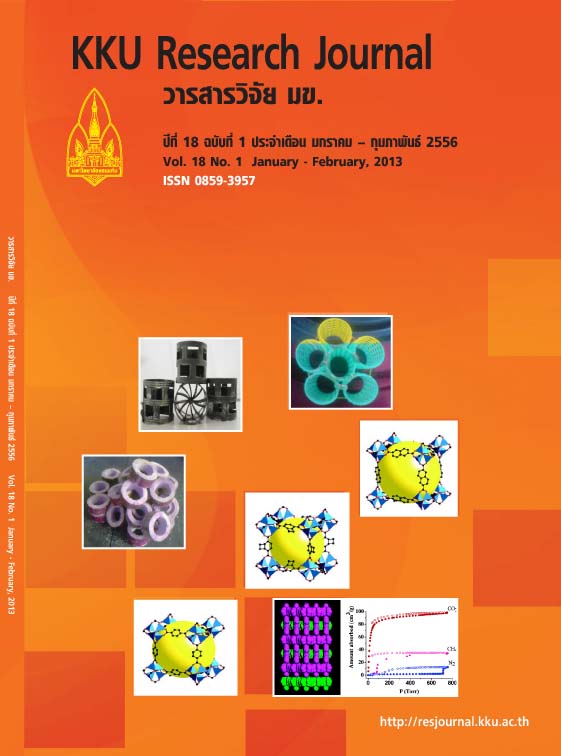Survey on protection of work hazards due to painting in automotive repair shop, Khon Kaen Municipality
Main Article Content
Abstract
This descriptive survey study aimed to study the protection of work hazards due to painting in automotive repair shops in Khon Kaen Municipality. There were 95 automobile repair shops in Khon Kaen Municipality where were permitted and operating. Data were collected by using the survey form and questionnaires. A total of 95 employers and 95 workers from each automobile repair shop by randomly sampling method were interviewed. Demographic characteristics, work accidents, work environmental factors, personal protective equipment (PPE) and annual medical check up were evaluated using questionnaires. The data were analyzed by conventional descriptive statistics: frequency, percentage, mean and standard deviation. The results showed that all of automobile repair shops located in a community. The workplace area was less than 400 square meters for 73 shops (76.84%) and the maximum and minimum areas were 8,000 m2 and 16 m2, respectively. Most of shops were operated for ? 6 years (37.89%), followed by >6 - 13 years (27.37%), respectively. Shops were opened for 9 hours per day for 78.95% and shops were closed on Sunday for 91.58%. The average of repair service was for 1-3 cars per day (77.90%). There were 1-3 workers in the shop for 77.66%. The major automotive service was machine repair for 43.16%, followed by lubricator change for 27.37% and painting for 24.21%. Most shops had no specific booth for painting and used general area in the shop for 78.26%. The others had the booth for painting but there were no ventilation systems or there were the systems without functioning. Most shops had no protection of painting spray spreading into atmosphere (86.96%). Among 95 workers, all workers were male, age was between 28-37 years for 40.01%, and work experience was less than 1 year for 52.63%. Most workers had no working suite for 86.32%. They used mostly cotton gloves for 54.47%. Workers had no personal protective equipment (PPE) for painting (86.96%) because of no support from their employers. Workers had not been medical checked up annual for 73.68%. The findings showed that the workers and nearby residences might be affected by exposure to chemicals from painting in the automotive repair shops. There must be the painting booth available in the service shop included the ventilation system, the simple of waste and air treatment or painting process with the spray gun in order to protect chemical hazards in work environment. The employer should provide PPE and control of using PPE among workers and support workers the annual medical examination or at risk.
Article Details
References
[2] Kimbite. Knowledge in car painting [Internet]. 2012 [updated 2007 Nov 27; cited 2012 Aug 30]. Available from: http://www.lancer-club.net/forum/index.php?topic=31102.0. Thai.
[3] Auto Refi nishing Shop Project, 2000b. HVLP spray guns: Cost-effective, environment-friendly technology. [Internet]. 2012 [Updated 2012 Jan 21; cited 2012 Mar 12]. Available from: http://www.epa.gov/dfe/pubs/auto/spraygun/
[4] Auto Refi nishing Shop Project, 2001e. Managing worker Health and Safety: An auto refi nish shop success story. [Internet]. 2012 [Updated 2012 Jan 21; cited 2012 Mar 12]. Available from: http://www.epa.gov/dfe/pubs/auto/trainers/index.htm
[5] Auto Refi nishing Shop Project, 2002f. Breathing Easy: Ensuring proper ventilation of paint mixing rooms in auto refi nish shops. [Internet]. 2012 [Updated 2012 Jan 21; cited 2012 Mar 12]. Available from: http://www.epa.gov/dfe/pubs/auto/trainers/index.htm
[6] Sparer J, Stowe MH, Bello D, Liu Y, Gore RJ, Youngs F, Cullen MR, Redlich CA, Woskie SR. Isocyanate Explosure in the autobody shop work : the SPRAY study. Journal of Occupational and Environmental Hygiene. 2004;1(9): 570–581.[7] Bello D, Herrick CA, Smith TJ, Wuskie SR, Streicher RP, Cullen MR, Liu Y, Redlich CA. Skin exposure to isocyanates: reasons for concern. Journal Environmental Health Perspect. 2007;115(3): 328-35.
[8] Jayjock MA, Levin L.. Health hazard in a small automotive body repair shop. Occupational Hygiene Society. Occupational Hygiene. 1984;28(1) : 19-29.
[9] Heitbrink WA, Wallace ME, Bryant CJ, Ruch WE. Control of paint overspray in autobody repair shops. Am Ind Hyg Assoc J. 1995;56(10): 1023-32.
[10] Auto Refi nishing Shop Project, 2000g. Respiratory Protection Program for Auto Refi nish Shops. [Internet]. 2012 [Updated 2012 Jan 21; cited 2012 Mar 12]. Available from: http://www.epa.gov/dfe/pubs/auto/trainers/index.htm
[11] Youcheng Liu; Meredith H. Stowe; Dhimiter Bello; Susan R. Woskie; Judy Sparer; Rebecca Gore; Fred Youngs; Mark R. Cullen; Carrie A. Redlich. Respiratory Protection from Isocyanate Explosure in the automotive repair and refi nishing industry.Journal of Occupational and Environmental Hygiene. 2006;3(5): 234–249.
[12]Parker DL, Waller K, Himrich B, Martinez A, Martin F. A cross-sectional study of pulmonary function in autobody repair workers. Am J Public Health. 1991;81 (6) : 768-71.
[13] Rose DN, Cummings CE, Molinaro J, Fertiq A. Screening for lead toxicity among autobody repair workers. Am J Ind Med. 1982;3 (4) : 405-12.
[14] Enander RT, Gute DM, Cohen HJ, Brown LC, Desmaris AM, Missaghian R. Chemical characterization of sanding dust and methylene chloride usage in automotive refinishing: implications for occupational and environmental health. AIHA J. 2002;63(6): 741-9.


